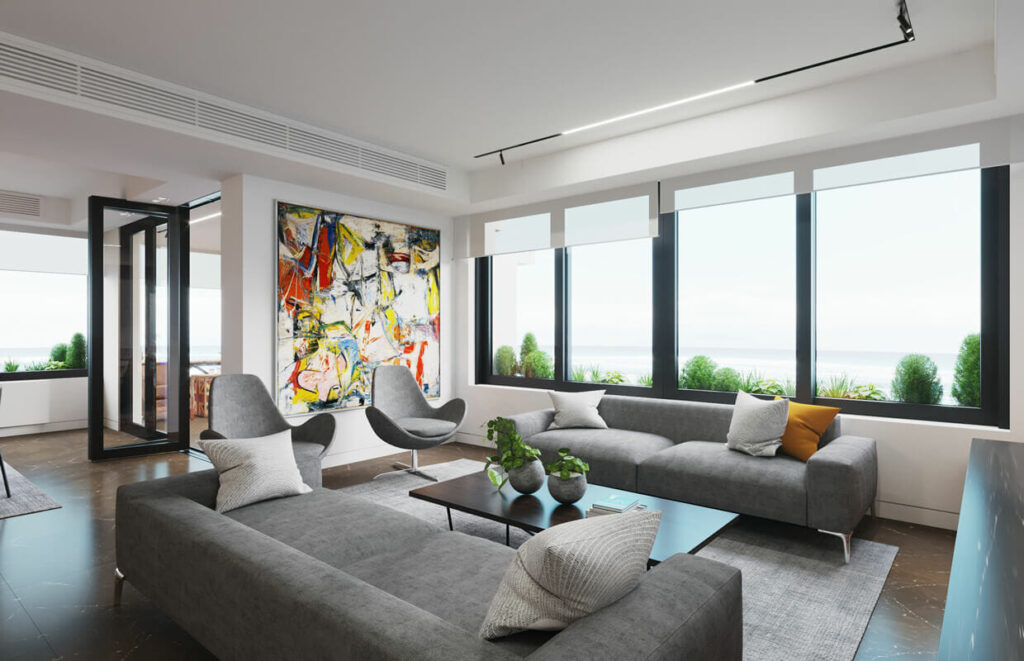Residential interior design involves creating functional and aesthetically pleasing living spaces in homes. It focuses on designing spaces that reflect the homeowner’s lifestyle and personal style while incorporating functionality and comfort.
There are several elements to consider when designing a residential interior, including color scheme, lighting, furniture, accessories, and textiles. The design should take into account the needs and preferences of the homeowner, including any specific functional requirements, such as accommodating a growing family or creating a home office.
Color scheme is an essential aspect of residential interior design, and it can have a significant impact on the overall feel of a space. Neutral colors like beige, white, and gray are popular choices for creating a clean and cohesive look, while bolder hues can add visual interest and create a sense of personality.
Lighting is another critical element in residential interior design, as it can impact the mood and ambiance of a space. A combination of ambient, task, and accent lighting can be used to create a warm and inviting atmosphere, while pendant lights, chandeliers, and wall sconces can add visual interest and create focal points.
Furniture selection is crucial in residential interior design, as it should be functional, comfortable, and visually appealing. It’s important to consider the size of the space when selecting furniture pieces, as well as the layout and flow of the room.
Accessories, such as artwork, mirrors, and decorative items, can add personality and visual interest to a space. Textiles, such as curtains, rugs, and throw pillows, can also add warmth and texture to the space while incorporating color and pattern.
Overall, residential interior design involves creating functional and aesthetically pleasing living spaces that reflect the homeowner’s lifestyle and personal style. With the right design elements and attention to detail, a residential interior can be transformed into a comfortable and inviting home.
Tips For Residential Interior Design Process
The residential interior design process can be a complex and challenging one, but with the right approach, it can also be an exciting and fulfilling experience. Here are some tips to help you navigate the residential interior design process:
- Define Your Style: Start by defining your personal style and preferences. Gather inspiration from magazines, online resources, and social media to help you identify your design aesthetic and create a vision board of your favorite design elements.
- Set a Budget: Determine your budget early in the design process and stick to it. This will help you prioritize your design choices and avoid overspending.
- Consider Functionality: Consider the functionality of each space and how it will be used. For example, a home office will require different design elements than a family room.
- Space Planning: Create a space plan that optimizes the flow and function of the space. Consider the placement of furniture, the traffic flow, and the natural lighting in each room.
- Color and Material Selection: Select a color palette and materials that complement each other and reflect your personal style. Consider the texture and durability of materials, especially for high-traffic areas.
- Lighting Design: Incorporate a lighting design that creates ambiance and functionality. Consider the different types of lighting, such as ambient, task, and accent lighting, and how they can be used in each space.
- Furniture and Decor Selection: Select furniture and decor that reflects your personal style and complements the design elements of each space. Choose pieces that are functional, comfortable, and visually appealing.
- Collaborate with Professionals: Consider hiring a professional interior designer to help you navigate the design process, offer expert advice, and ensure that the final result is a cohesive and well-designed space.
Overall, the residential interior design process involves careful consideration of design elements, functionality, and personal style. By following these tips and taking a thoughtful approach to the design process, you can create a space that is both functional and aesthetically pleasing.

